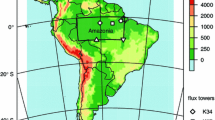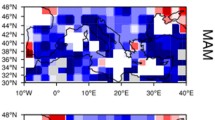Abstract
The importance of clouds in the upper troposphere (cirrus) for the sensitivity of the Earth's climate e.g., requires that these clouds be modeled accurately in general circulation model (GCM) studies of the atmosphere. Bearing in mind the lack of unambiguous quantitative information on the geographical distribution and properties of high clouds, the simulated distribution of upper tropospheric clouds in a spectral GCM is compared with several satellite-derived data-sets that pertain to high clouds only, for both winter and summer seasons. In the model, clouds are assumed to occupy an entire gridbox whenever the relative humidity exceeds 99%: otherwise the grid box is assumed to be free of cloud. Despite the simplicity of the cloud prediction scheme, the geographical distribution of the maxima in the model's upper tropospheric cloud cover coincides approximately with the regions of the observed maxima in the high cloud amount and their frequency of occurrence (e.g., intertropical convergence zone and the monsoon areas). These areas exhibit a minimum in the outgoing longwave radiation (OLR; Nimbus-7) and are also coincident with regions of heavy precipitation. The model, with its relatively simple cloud formation scheme, appears to capture the principal large-scale features of the tropical convective processes that are evident in the satellite and precipitation datasets, wherein the intense, upward motion is accompanied by condensation and the spreading of thick upper tropospheric layers of high relative humidity and cloudiness in the vicinity of the tropical rainbelt regions.
Similar content being viewed by others
References
Barton IJ (1983) Upper level cloud climatology from an orbiting satellite. J Atmos Sci 40:435–447
Jaeger L (1976) Monthly precipitation maps for the entire earth (in German). Ber Dtsch Wetterdienstes 18:139
Kyle HL, Arduany PE, Hucek RR, The Nimbus-7 ERB Experiment Team (1986) El Niño and outgoing longwave radiation: An Atlas of Nimbus-7 Earth Radiation Budget Observations. NASA Reference Publication 1163
Lacis A, Hansen J (1974) A parameterization for the absorption of solar radiation in the earth's atmosphere. J Atmos Sci 31:118–133
London J (1957) A study of the atmospheric heat balance. Final Report, AFCRC Contract AF 19(122)-165, New York University (DDC AD 117227)
Manabe S (1969) Climate and the ocean circulation: I. The atmospheric circulation and the hydrology of the earth's surface. Mon Wea Rev 97:739–774
Manabe S, Hahn DG (1981) Simulation of atmospheric variability. Mon Wea Rev 109:2260–2286
Manabe S, Hahn DG, Holloway JL Jr (1979) Climate simulations with GFDL spectral models of the atmosphere: effect of spectral truncation. Rep of the JOC Study Conf on Climate Models: performance intercomparison and sensitivity studies, Washington DC, 3–7 April 1978. GARP Publ Ser No 22, Vol 1, 41–94 (NTIS N8027917)
Manabe S, Smagorinsky J, Strickler RJ (1965) Simulated climatology of a general circulation model with a hydrological cycle. Mon Wea Rev 93:769–798
Newell RE, Kidson JW, Vincent DG, Boer GJ (1974) The general circulation of the tropical atmosphere. Vol 2, Chap 9, MIT Press, Cambridge MA, USA
Prabhakara C, Fraser RS, Dalu G, Wu Man-li C, Curran RJ (1988) Thin cirrus clouds: Seasonal distribution over oceans deduced from Nimbus-4 IRIS. J Appl Meteor 27:379–399
Ramanathan V (1987) Atmospheric general circulation and its low frequency variance: Radiative influences. J Meteor Soc Japan 65:151–175
Ramanathan V, Pitcher EJ, Malone RC, Blackmon ML (1983) The response of a general circulation model to refinements in radiative processes. J Atmos Sci 40:605–630
Ramaswamy V, Ramanathan V (1989) Solar absorption by cirrus clouds and the maintenance of the tropical upper troposphere thermal structure. J Atmos Sci 46:2293–2310
Rodgers CD, Walshaw DC (1966) The computation of infra-red cooling rate in planetary atmospheres. Quart J R Meteorol Soc 92:67–92
Schlesinger ME, Mitchell JFB (1987) Model projections of the equilibrium climatic response to increased CO2. Rev Geophys 25:760–798
Stone HM, Manabe S (1968) Comparison among various numerical models designed for computing infrared cooling. Mon Wea Rev 96:735–741
Stowe LL, Yeh HYM, Fox TF, Wellemeyer CG, Kyle HL, The NIMBUS-7 Cloud Data Processing Team (1989) Nimbus-7 global cloud climatology. Part II: First year results. J Climate 2:671–709
Wetherald RT, Manabe S (1980) Cloud cover and climate sensitivity. J Atmos Sci 37:1485–1510
Wetherald RT, Manabe S (1988) Cloud feedback processes in a general circulation model. J Atmos Sci 45:1397–1415
Woodbury GE, McCormick MP (1986) Zonal and geographical distributions of cirrus clouds determined from SAGE data. J Geophys Res 91:2275–2787
Author information
Authors and Affiliations
Rights and permissions
About this article
Cite this article
Wetherald, R.T., Ramaswamy, V. & Manabe, S. A comparative study of the observations of high clouds and simulations by an atmospheric general circulation model. Climate Dynamics 5, 135–143 (1991). https://doi.org/10.1007/BF00251805
Received:
Accepted:
Issue Date:
DOI: https://doi.org/10.1007/BF00251805




